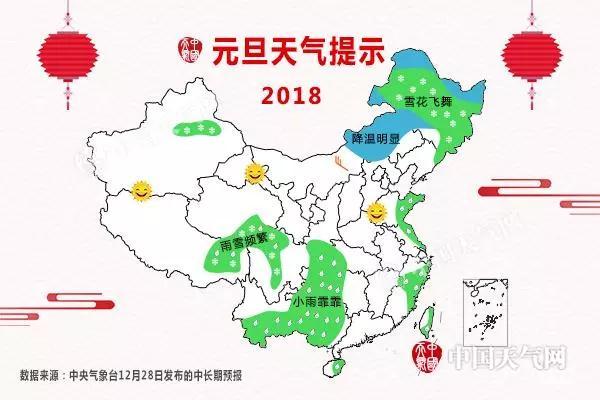What’s the weather like on New Year’s Day holiday? Travel must see.
CCTV News:Pay attention to the weather during the New Year holiday. According to the news of China Meteorological Bureau yesterday, during the New Year’s Day holiday in 2018 (December 30 to January 1), most parts of the country are mainly sunny and suitable for travel; There will be rain and snow in parts of the northeast and southwest, and strong winds and cooling may occur in the central and eastern regions due to the influence of cold air.

The Central Meteorological Observatory predicts that during the New Year’s Day holiday in 2018, most parts of the country will be mainly sunny and suitable for travel; There will be rain and snow in parts of the northeast and southwest, and strong winds and cooling may occur in the central and eastern regions due to the influence of cold air.
During the period, on the 30th, due to the influence of cold air, the temperature dropped by 4 ~ 8℃ from west to east and from north to south in eastern China, and it was 10℃ in some areas. There are 4 ~ 6 northerly winds in the Yangtze River and most of its northern areas; From 31st to 1st January, there was light snow in the eastern and northeastern parts of Inner Mongolia, with moderate to heavy snow in the eastern part of Northeast China. There is light rain (light snow at high altitude) in southwest China, western South China and western Jiangnan, and precipitation is scarce in most other areas.
Cold air strikes: the smog in Huanghuai, North China will improve, and there is moderate to heavy snow in the northeast.
The Central Meteorological Observatory predicts that the foggy and hazy weather in North China, Huanghuai and other places will be the heaviest in this round on the 29th.The Central Meteorological Observatory issued a foggy orange warning at 6: 00. On the 30th, affected by cold air, the air quality began to improve. As the cold air continues to move southward, the areas with high temperature in China will gradually return to normal level.

When cold air strikes, the smog will gradually weaken from north to south.
This morning, some parts of Beijing were caught in heavy fog, with low visibility, and some expressways were closed for a time. In Shandong, at 6 o’clock this morning, the Shandong Meteorological Observatory issued a foggy red warning. In some areas of Liaocheng, Dezhou, Binzhou, Dongying, Jinan, Zibo, Weifang, Jining, Zaozhuang and Rizhao, the visibility is less than 50 meters.Affected by bad weather, as of 9: 00 am, more than 300 toll stations of G2 Beijing-Shanghai Expressway, G20 Qingyin Expressway and other expressways were temporarily closed.
In addition, from the morning of the 29th to the 30th, the atmospheric diffusion conditions in central and southern North China, Huanghuai, Jianghuai, Jianghan and Sichuan Basin were poor, with mild to moderate haze, with severe haze in central and southern North China, central and western Huanghuai and Jianghan. Since the 30th, the North China Plain, Huanghuai and other places have been affected by cold air, and the atmospheric diffusion conditions have gradually improved.Haze weather gradually weakens and dissipates from north to south, but due to the influence of upstream transportation, haze will be aggravated in parts of Huanghuai, Jianghuai, Jianghan and northern Jiangnan.
Meteorologists reminded that due to the fog and haze weather,If the public has a travel plan, it is necessary to plan the driving route in advance and check the accessible sections. The public should wear masks and hats when going out. Try to minimize outdoor sports and exercise in haze weather. Wash your face in time after returning home and wash your mouth and nose with normal saline. In some areas, visibility is low due to fog. When driving, you need to turn on fog lights, slow down and pay attention to pedestrians.
Tomorrow and the day after tomorrow, there will be heavy snow in eastern Jilin and precipitation in southern Jilin will end, and the temperature will drop.
On the 27th, due to the influence of cold air, there were heavy snowstorms along the Tianshan Mountains in northern Xinjiang. Monitoring shows that at 8: 00 am on the 28th, the snow has reached 36 cm. In addition, snowflakes also appear in western Qinghai and eastern Liaoning.

The Central Meteorological Observatory predicts that there will be light snow or sleet in northwestern Xinjiang, central and eastern Qinghai, northern Sichuan Plateau and central Shandong from 08: 00 on December 29 to 08: 00 on December 30. There are small to moderate rains in the eastern part of Southwest China, western Jiangnan, western South China, central and eastern Hainan Island and parts of Taiwan Province.
Tomorrow and the day after tomorrow, there will be a large range of snowfall in eastern Inner Mongolia, Jilin and Heilongjiang, especially in eastern Jilin.For the snow-poor area of Beijing, Tianjin and Liaoning, there is still basically no possibility of snowfall in this cold air activity. With the southward movement of cold air, it will still be rainy in Jiangnan and western South China tomorrow, but the intensity is generally not strong, mainly light rain, with moderate rain in the local area. It will generally clear up the day after tomorrow, but the air will become dry again.
Meteorologists reminded that,There will be snowfall in Northeast China, Inner Mongolia and other places tomorrow and the day after tomorrow. The public should be careful about road snow and ice, and be careful when crossing the road. Affected by cold air, the temperature in most parts of the country will drop again. The public should pay attention to cold and warmth, and be careful of catching a cold.